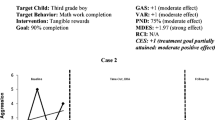Abstract
Single-case research is a prevalent and useful method for evaluating the effects of interventions in special education research. A single-case graph “should make available all of the data that permit evaluation of the criteria for visual inspection, at the very least,” while not misleading inspectors (Kazdin, 2011, p. 335). Although this is widely known, it poses challenges for multifaceted dependent variables, such as those that address both rate and a measure of quality, such as fidelity. Both factors may be important to accurately interpret intervention effects, such as those within cascading interventions implemented by natural change agents. However, representing both in a single graph is challenging. In response to this challenge, we present a single data set from a multiple-baseline design graphed in six distinct formats. Across these graphs, we discuss implications for visual analysis and interpretation and invite discussion of this important area of single-case research in search of recommendations for best practice.






Similar content being viewed by others
References
Barton, E. E., Lloyd, B. P., Spriggs, A. D., & Gast, D. L. (2018). Visual analysis of graphic data. In J. Ledford & D. Gast (Eds.), Single case research methodology: Application in special education and behavioral sciences (3rd ed., pp. 179–214). Routledge.
Barton, E. E., Meadan, H., & Fettig, A. (2019). Comparison of visual analysis, non-overlap methods, and effect sizes in the evaluation of parent implemented functional assessment based interventions. Research in Developmental Disabilities, 85, 31–41. https://doi.org/10.1016/j.ridd.2018.11.001.
Barton, E. E., & Reichow, B. (2012). Guidelines for graphing data with Microsoft® Office 2007™, Office 2010™, and Office for Mac™ 2008 and 2011. Journal of Early Intervention, 34(3), 129–150. https://doi.org/10.1177/1053815112456601.
Individuals With Disabilities Education Improvement Act (IDEIA) of 2004, 20 U.S.C. § 1400 et seq. (2004). http://idea.ed.gov/explore/view/p/%2Croot%2Cstatute%2C
Institute of Education Science. (2018). Request for applications: Special education research grants (CFDA No. 84.324A). https://ies.ed.gov/funding/pdf/2019_84324A.pdf
Kazdin, A. E. (2011). Single-case research designs: Methods for clinical and applied settings (2nd ed.). Oxford University Press.
Kratochwill, T. R., Hitchcock, J., Horner, R., Levin, J. R., Odom, S. L., Rindskopf, D. M., & Shadish, W. R. (2013). Single-case intervention research design standards. Remedial and Special Education, 34(1), 26–38. https://doi.org/10.1177/0741932512452794.
Lane, J. D., Shepley, C., & Spriggs, A. D. (2019). Issues and improvements in the visual analysis of A-B single-case graphs by pre-service professionals. Remedial and Special Education. Advance online publication. https://doi.org/10.1177/0741932519873120.
Ledford, J. R., & Gast, D. L. (2018). Single case research methodology: Applications in special education and behavioral sciences (3rd ed.). Routledge.
Meadan, H., Snodgrass, M. R., Meyer, L. E., Fisher, K. W., Chung, M. Y., & Halle, J. W. (2016). Internet-based parent-implemented intervention for young children with autism: A pilot study. Journal of Early Intervention, 38(1), 3–28. https://doi.org/10.1177/1053815116630327.
Ninci, J. (2019). Single-case data analysis: A practitioner guide for accurate and reliable decisions. Behavior Modification. Advance online publication. https://doi.org/10.1177/0145445519867054.
Parsonson, B. S., & Baer, D. M. (1978). The analysis and presentation of graphic data. In T. R. Kratochwill (Ed.), Single subject research: Strategies for evaluating change (pp. 101–166). Academic Press.
Romano, M., & Woods, J. (2018). Collaborative coaching with Early Head Start teachers using responsive communication strategies. Topics in Early Childhood Special Education, 38(1), 30–41. https://doi.org/10.1177/0271121417696276.
Snodgrass, M. R., Chung, M. Y., Meadan, H., & Halle, J. W. (2018) Social validity in single-case research: A systematic literature review of prevalence and application. Research in Developmental Disabilities, 74, 160–173. https://doi.org/10.1016/j.ridd.2018.01.007.
Spriggs, A. D., Lane, J. D., & Gast, D. L. (2014). Visual representation of data. In D. L. Gast & J. R. Ledford (Eds.), Single case research methodology: Applications in special education and behavioral sciences (2nd ed., pp. 154–175). Routledge.
Van Houten, R. (1979). Social validation: The evolution of standards of competency for target behaviors. Journal of Applied Behavior Analysis, 12(4), 581–591. https://doi.org/10.1901/jaba.1979.12-581.
Wolf, M. M. (1978). Social validity: The case for subjective measurement or how applied behavior analysis is finding its heart. Journal of Applied Behavior Analysis, 11(2), 203–214. https://doi.org/10.1901/jaba.1978.11-203.
Wolfe, K., Barton, E. E., & Meadan, H. (2019). Systematic protocols for the visual analysis of single-case research data. Behavior Analysis in Practice, 12(2), 491–502. https://doi.org/10.1007/s40617-019-00336-7.
Wright, C. A., & Kaiser, A. P. (2017). Teaching parents enhanced milieu teaching with words and signs using the teach-model-coach-review model. Topics in Early Childhood Special Education, 36(4), 192–204. https://doi.org/10.1177/0271121415621027.
Author information
Authors and Affiliations
Corresponding author
Ethics declarations
Conflict of Interest
The authors have no conflicts of interest to declare.
Ethical Approval
The data presented here were gathered with the approval of the Institutional Review Board of the University of Illinois Urbana-Champaign.
Informed Consent
The participant provided informed consent for her and her son’s participation.
Additional information
Publisher’s Note
Springer Nature remains neutral with regard to jurisdictional claims in published maps and institutional affiliations.
Rights and permissions
About this article
Cite this article
Snodgrass, M.R., Meadan, H., Chung, M.Y. et al. Graphing the Intersection of Rate and Fidelity in Single-Case Research. Behav Analysis Practice 15, 284–294 (2022). https://doi.org/10.1007/s40617-021-00556-w
Accepted:
Published:
Issue Date:
DOI: https://doi.org/10.1007/s40617-021-00556-w




